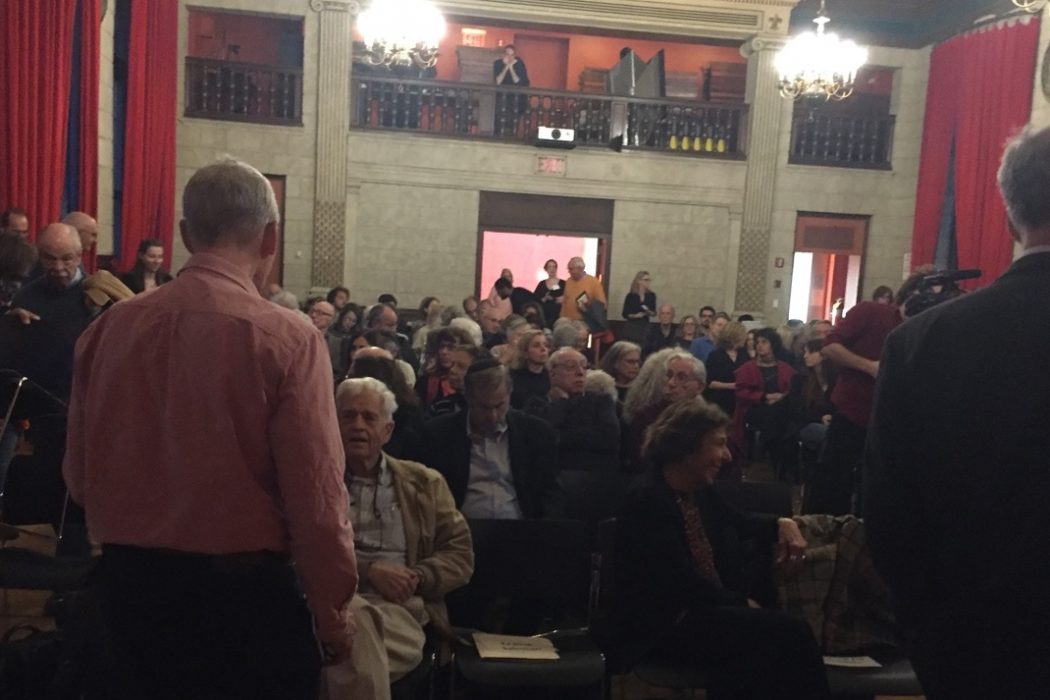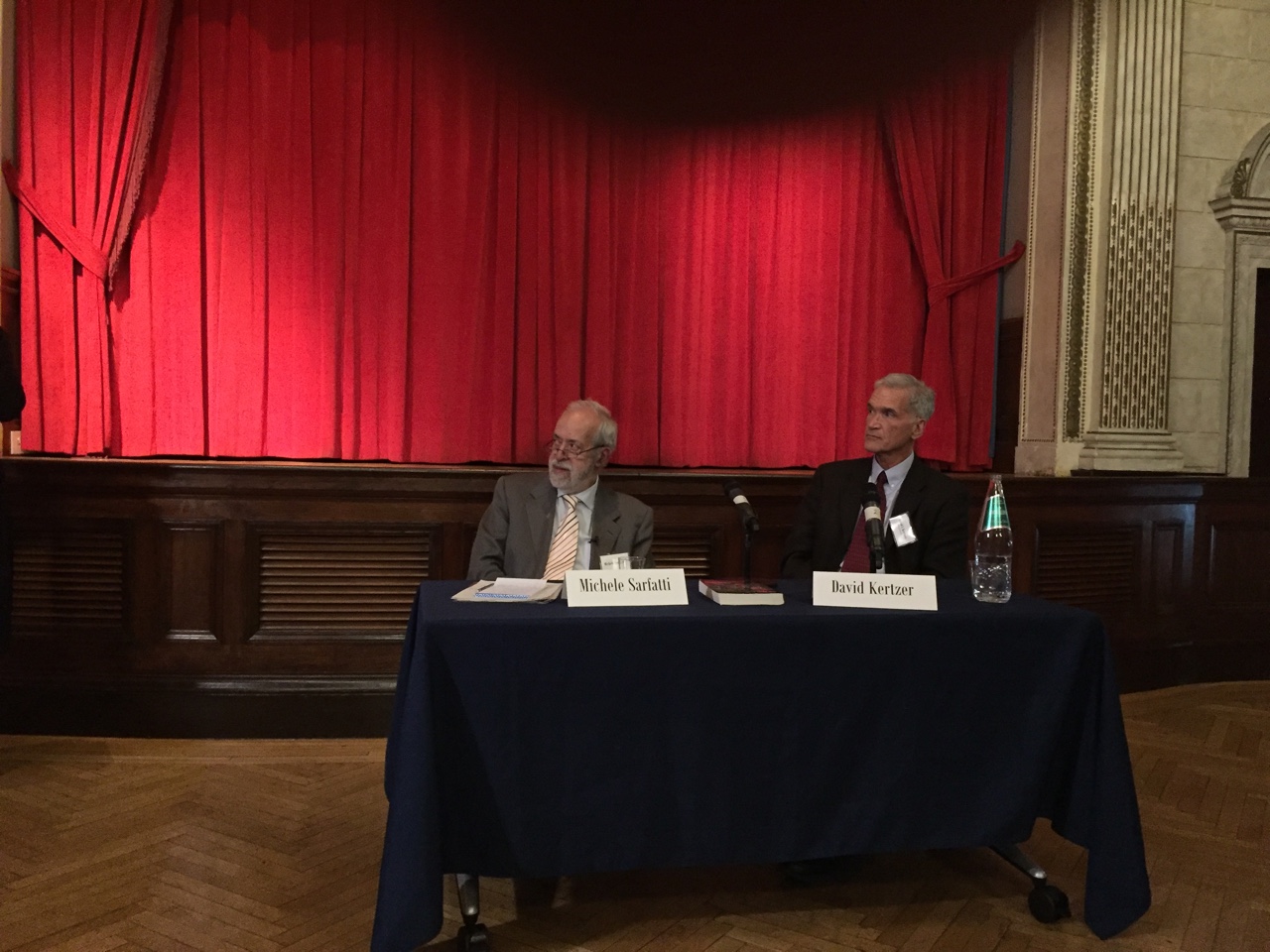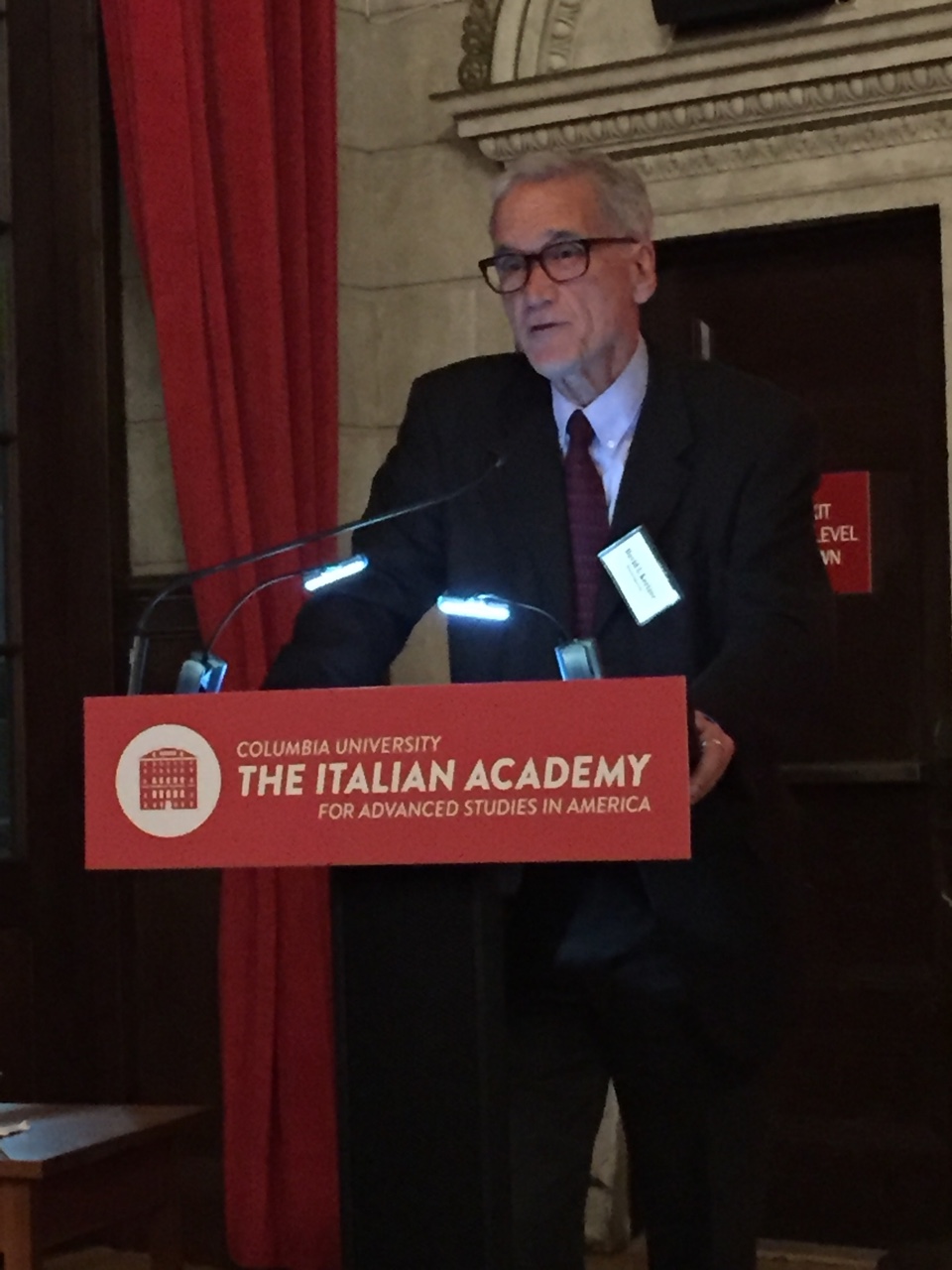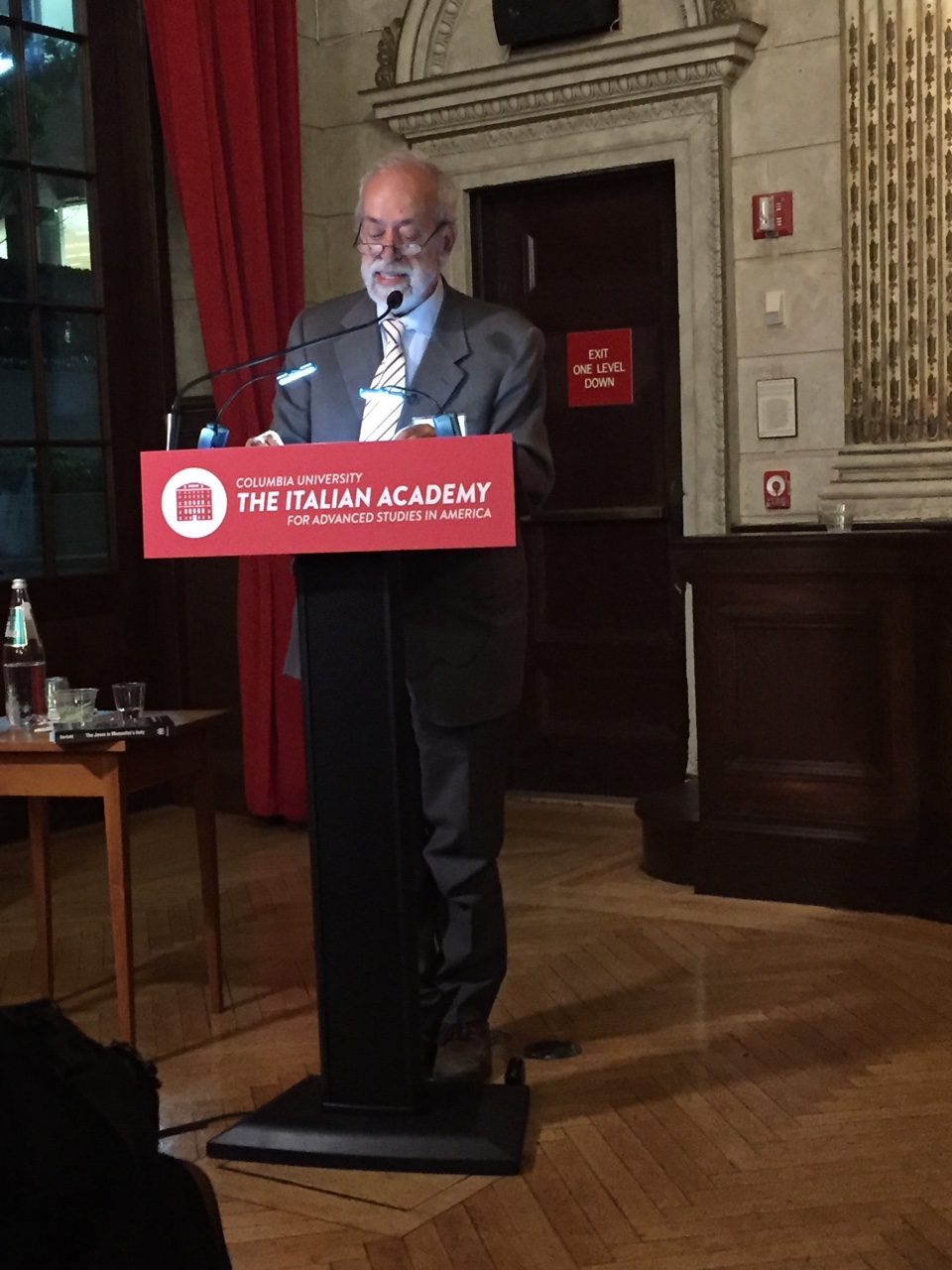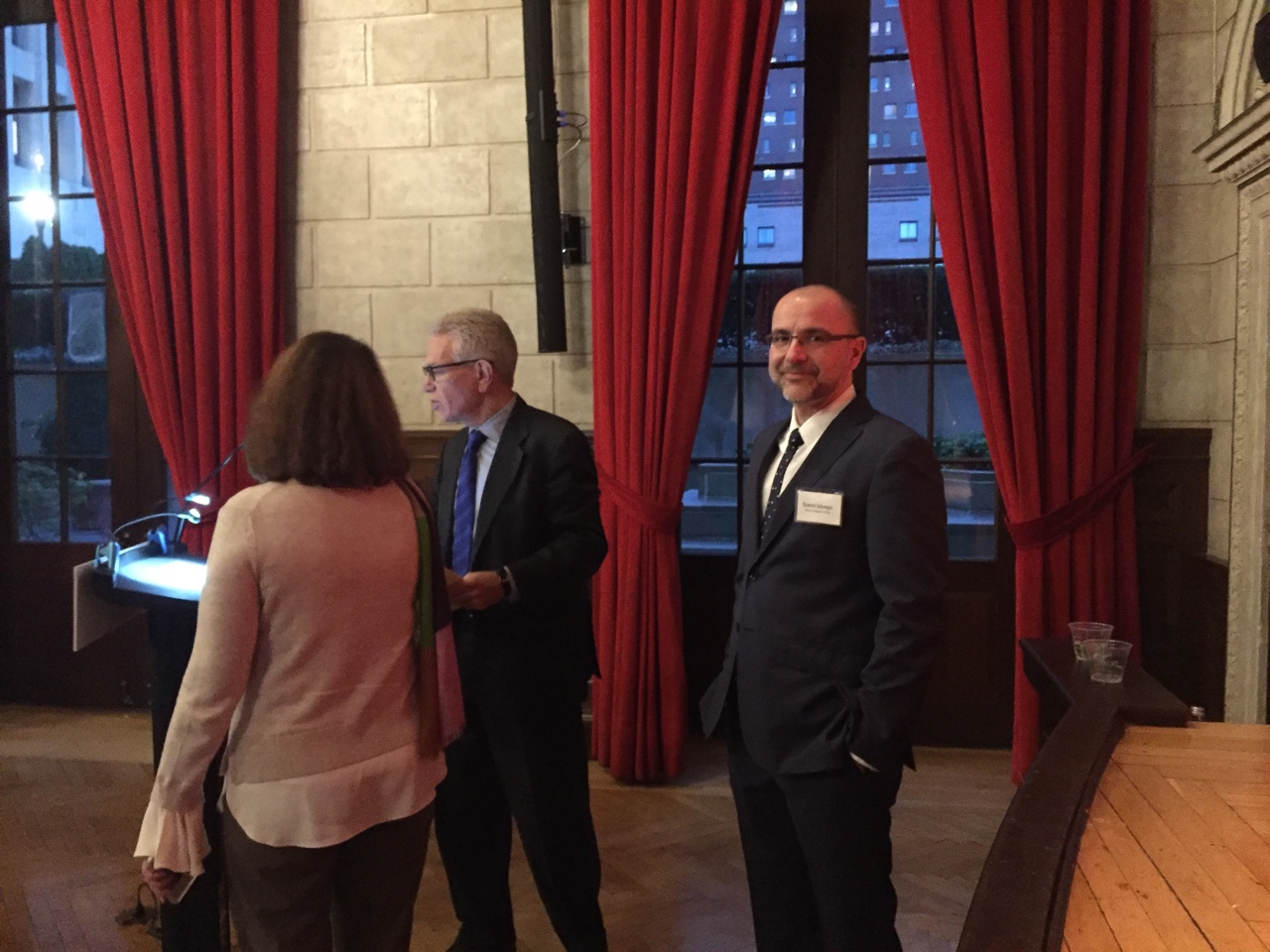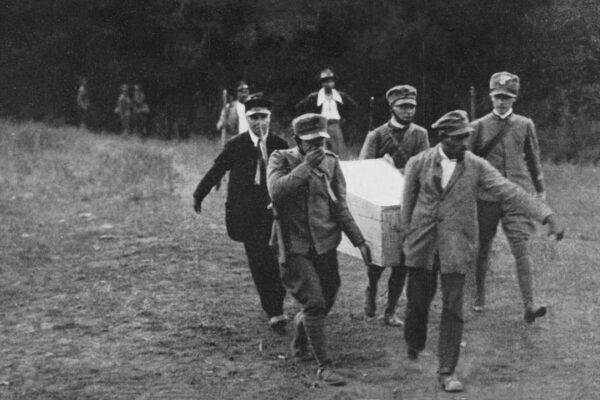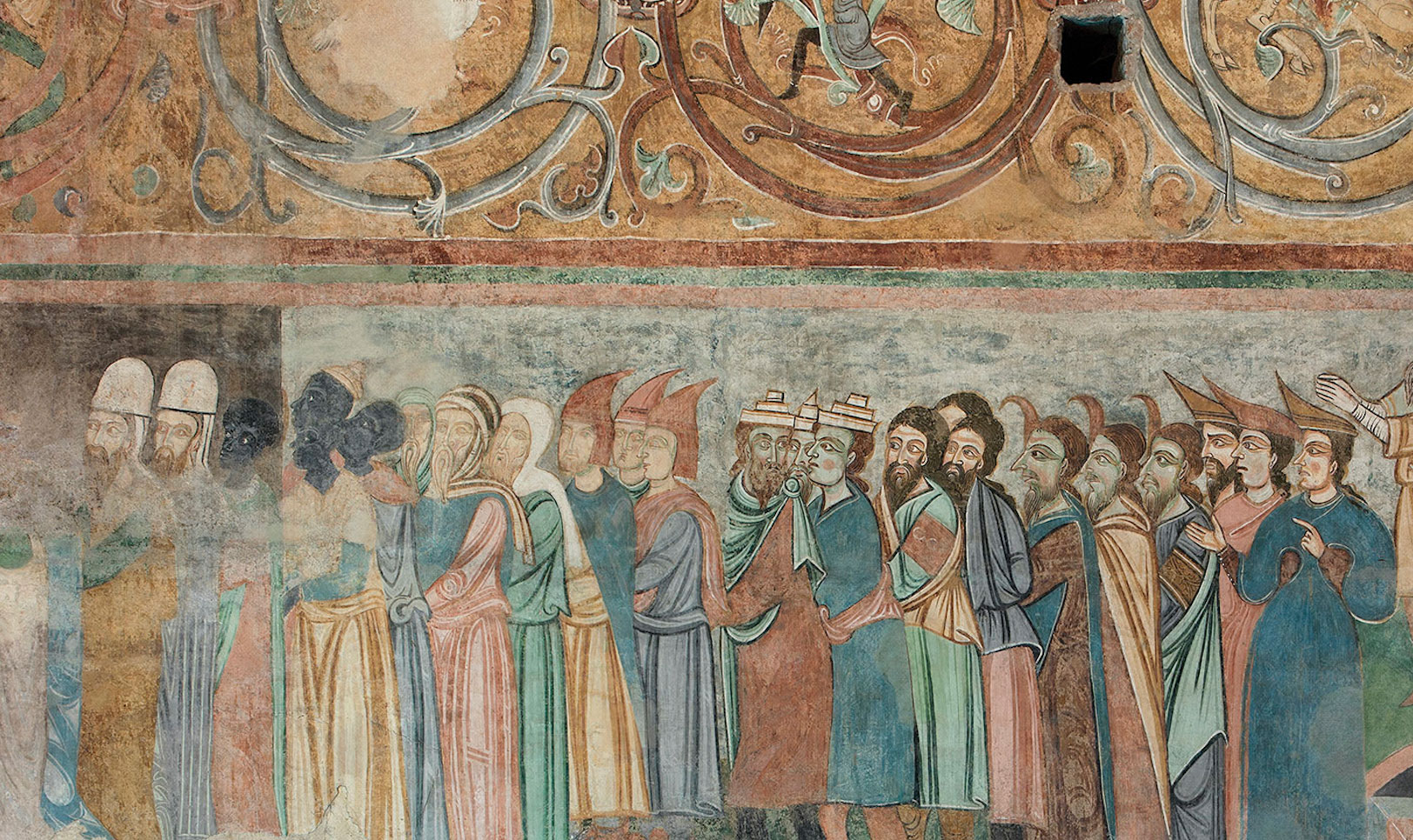A crowd of 250 people at the Italian Academy at Columbia University paid homage to historian Michele Sarfatti. Renowned for his groundbreaking research on Italian Jewry, Fascist antisemitism and the Shoah in Italy, Dr. Sarfatti was introduced by Prof. David Kertzer (Brown University) whose remarks highlighted how profoundly his research of forty years influenced Italian and international historiography.
The evening was presented by Centro Primo Levi and the Columbia University Seminar in Modern Italian Studies on the occasion of the upcoming publication of a special issue of the Journal of Modern Italian Studies focusing on the 80th anniversary of the implementation of the Racial Laws in Italy. The volume, edited and introduced by Annalisa Capristo and Ernest Ialongo, will be published in honor of Michele Sarfatti.
In his presentation entitled “Jews In Italy And Nazi And Fascist Persecution. Themes For Future Research,” Dr. Sarfatti discussed research areas that have not been sufficiently studied or have not been studied at all.
A member of the Italian delegation of IHRA, Dr. Sarfatti has been Coordinator and then Director of the Fondazione Centro di Documentazione Ebraica Contemporanea (CDEC) from 1982 to 2016. He has been member of “Government Commission to investigate the expropriation of Jewish assets between 1938 and 1945” (1998-2001).
A transcript of his talk follows.
Two months ago, in September 2018, I published in Italy a new updated and expanded edition of my book Gli ebrei nell’Italia fascista. Vicende, identità, persecuzione [The Jews in Fascist Italy. Events, Identity, Persecution]. The previous Italian edition had been translated into English and published in 2006 with the title The Jews in Mussolini’s Italy. From Equality to Persecution by the University of Wisconsin Press in its prestigious series named after historian George L. Mosse. (1)Having my book included in that series was a great honor for me, if only because in one of my essays, published in 2005 in a volume edited by Joshua D. Zimmerman, I had pointed out that in 1978 Mosse had unfortunately credited the incorrect assertion by Italian historian Renzo De Felice that Mussolini “was no racist”: later Mosse, basing himself also on my research, wrote in 1999 that Mussolini “had embraced racism”.(2)
The decision by the «Journal of Modern Italian Studies» to dedicate one of the Journal’s issues to my research is an infinitely greater honor and I am truly touched. I would like to thank all who had this idea, who carried it out, who supported it: the Journal’s editor, John A. Davis, the editors of this issue, Annalisa Capristo and Ernest Ialongo, the friends of the Primo Levi Center, Alessandro Cassin and Natalia Indrimi, all the scholars who have contributed essays to this issue. I wish to thank also the organizers of tonight’s event and the speakers, first of all David Kertzer. My greetings also go to Susan Zuccotti and all the other friends who are attending this evening which I feel has somehow a New Yorker atmosphere, involving as it does Italians and Jews.
* * * *
Usually a scholar talks about the contents of his latest book or about the research in which he is currently engaged. Today, however, I would like to speak about things that are not in my book, and of research that has not yet been undertaken and that I wish someone would take on: myself perhaps, but ideally also other historians.
For many decades I have been researching a field so vast and complex that ploughing through it, in all its length and breadth, requires more than one person, more than one research team. Let me give some examples.
For a start, there is a document many historians are familiar with: the Allied Governments’ “Joint Declaration” of December 17, 1942, which denounced to public opinion the massacre of “many hundreds of thousands” of Jews by “German authorities”, a “bestial policy of cold-blooded extermination”, and warned: “They [Those Governments] reaffirm their solemn resolution to insure that those responsible for these crimes shall not escape retribution, and to press on with the necessary practical measures to this end.”.(3)
I have been able to examine only a few of the newspapers published in Italy about that date and have found no direct mention of the Declaration. I saw however that the «Corriere della Sera» of December 20 published a short article on the German government’s reaction to what it described as a “joint declaration […] concerning the Jewish question”. (4) At the same time, news that there was an Allied text “protesting against the cruelties, oppressions and deportations of European Jews under German domination”, and that Italian newspapers had published the German reaction to it, quickly reached the foreign Jews interned in the camp at Ferramonti di Tarsia, in Calabria, who mentioned it in an appeal dated December 25. (5)
The Declaration, then, or at least its first part, did circulate in Italy to some extent. It would be important to investigate how it was reported in the press of neutral countries that was available in Italy, in Radio London broadcasts, in the correspondence of Italian diplomats. I am inclined to believe, however, that we can state with a sufficient degree of certainty that the highest civil and military authorities of the Italian State were aware quite early at least of the Declaration’s first part. Actually, I believe that they probably had knowledge of the second part as well, the one containing the warning, but for the time being I am not aware of any document proving this.
It should be noted that the Declaration referred only to “German authorities”, without mentioning institutions or persons having a different nationality. It did however censure both independent and quisling governments that were allied with the Third Reich. Moreover, one must consider that the Declaration was issued shortly after the victory at El Alamein and the shift in the balance of power at Stalingrad: the defeat of the Axis had now become a concrete possibility, albeit a still distant prospect.
It is within this general context that one must place the second document. It is a short note on a telephone conversation that took place on January 26, 1943, i.e. forty days after the Declaration had been published. The note is to be found in the daily staff journal recording the activities of the Supreme Command of the Italian Armed Forces and summarizes a telephone call made by Ugo Cavallero, Chief of the Defence Staff, i.e. Commander of the Italian Armed Forces, to Mario Vercellino, Commander of the Fourth Army, stationed in occupied France. The text reads: “0950 hours. [Cavallero] calls His Exc. Vercellino. Topic: Publication in foreign newspapers of a proclamation deploring the fight against Jews”.(6)
As far as I know, the only “proclamation” around that time that matches this description is the Declaration of December 17.
No further documents or traces of documents related to this note have been found as yet. The note itself does not state who is responsible for the “fight against Jews”, nor does it describe the said fight. The verb used in Italian is “deplorare”, which I feel conveys not just a sense of condemnation but also a little pity towards the victims and some officiality.
Basically, then, we know only what is written in the note. We don’t know, for instance, if Cavallero and Vercellino were acquainted with just a summary or with the full text of the first part of the Declaration. We don’t know if one or both of them were also aware of the final warning. We don’t know if this telephone conversation of January 26 was or was not the first they had on this subject. We don’t know which of the two was better informed. We don’t know whether they were in agreement or if their views on the subject diverged. We don’t know if they also discussed the situation of Jews in South-East France occupied by the Fourth Army.
And yet I would like to know more. Perhaps a meticulous sifting of chronologies, diaries, newspaper collections, military and diplomatic papers, and documents from other government agencies might take us a few steps forward. In any case, the fact of two Italian officers of the highest rank talking about the Allied Declaration against the slaughter of Jews by the Nazis seems to me of huge interest both for the history of Italy and for the history of the reception and the effects of that document.
And if – as happens to all historians once in a while, when times seem perversely inauspicious – it should prove absolutely impossible to find any further document relating to that call of January 26, we can be sure that – as happens quite often to historians, when times turn gloriously auspicious – somebody will stumble upon other documents not connected to the December 17 Declaration, but connected to events at least as important.
* * * *
The second document I would like to talk about is written in Hungarian and was first published by Jenö Lévai in 1948. It contains a passage about Italy, the importance of which was pointed out fifty years later by the historian Peter Longerich.
The document is a dispatch that the Hungarian ambassador to the Third Reich, Döme Sztójay, sent to his government on April 28, 1943, reporting on a lengthy conversation he had had with the Foreign Minister Joachim von Ribbentrop about the persecution of Jews. In the course of that conversation, according to the Hungarian’s report, Ribbentrop had told him that during a recent meeting between Benito Mussolini and Adolf Hitler they had discussed the treatment of Italian Jews. This is absolute news, something that has never emerged from any document known so far.
On April 28, then, Sztójay reported that Ribbentrop had told him that almost all governments had implemented radical measures against Jews, i.e. the radical measures of general deportation or internment, and that “the Duce, too, during his recent visit to Salzburg, has announced to the Führer that he would arrest all his Jews”. In the course of the conversation the Nazi minister (Ribbentrop) had then again stated that “the Duce too would intern all Jews”. (7) The long dispatch clearly shows that the German minister (and the Hungarian ambassador himself) exerted pressure towards a harsher anti-Jewish persecution in Hungary. What concerns us here, however, are the two references to Mussolini. The Italian dictator visited Klessheim Castle, near Salzburg, from April 7 to April 10, 1943, and there had several meetings with Hitler; the ambassadors of the two countries, the Italian Under-Secretary of State for Foreign Affairs Giuseppe Bastianini and the German minister Ribbentrop were present at some of them. The information that has reached us about these meetings is scant and does not mention that the two dictators discussed the fate of Italian Jews. Ribbentrop’s account to Sztójay cannot therefore be verified and might not be entirely truthful.
Having said that, I would like to add that it seems to me rather unlikely that the Nazi minister’s account of what Mussolini had said was entirely a fabrication, although I cannot of course rule it out. I believe instead one can safely assume that the Italian dictator may have mentioned an idea just then taking shape, i.e. the creation of internment and forced labor camps for able Jews, both male and female, which would reach the concrete planning stage by May 1943 at the latest. If this assumption is correct, we can conjecture that in early April the dictator was already contemplating such a measure.
As mentioned before, this is only a conjecture, at present based on foundations as solid as the sands of an ocean shore. In this instance, as in others, further research is needed, crosschecking new sources and re-examining known sources that we had not investigated thoroughly in this respect: what was said between the two dictators at Klessheim in April 1943? Did Mussolini inform Hitler that he intended to step up the persecution of Jews in Italy? Did they also discuss the systematic massacre then being carried out in the territories under the Third Reich’s control? Did Hitler ask Mussolini what he intended to do with the Italian Jews that the two dictators had agreed would be repatriated from those territories? Had Mussolini really begun to envisage the creation of labor camps? There is a great deal of work that still needs to be done.
On a wider level, this document points to how important it is to examine diplomats’ correspondence in general and to look for mentions of third countries in letters not dealing primarily with them. Who knows if some interesting information about Italy may not emerge from in other Hungarian documents, or perhaps from Rumanian ones, or from those of some other country.
* * * *
The third and fourth documents I would like to talk about are part of the OSS records, kept by the CIA, declassified and examined in 2000 by Richard Breitman’s and Timothy Naftali’s research team. These two writings, dated October 6, 1943, and sent by Germans in Rome to other German officials, were intercepted and translated or summarized by British Intelligence and then forwarded to the OSS. The first message reported that Herbert Kappler, chief of German police in Rome, had been ordered by Berlin “to seize and to take to Northern Italy the 8,000 Jews living in Rome”; the second was a telegraphic dispatch by Kappler himself reporting that: “Office preparations for action [i.e. for the arrest and deportation of Jews] in Rome have been concluded”.(8)
These quotes, obviously, are taken from the translations made by the British, but I take it for granted that they are faithful to the original texts. Both documents therefore attested that a great roundup of Roman Jews was imminent. In the following days this was mentioned also in other German documents, but what concerns us here are these first two ones.
The roundup took place ten days later, on Saturday, October 16, 1943; on October 18 German police deported 1,020 people to Auschwitz-Birkenau. Among them was a baby born after his mother had been arrested. Italian police collaborated by making lists of Jews living in each street.
In the summer of 2000 the Italian press gave much attention to the CIA-OSS documents about Rome. Some journalists and historians raised the question whether the advance knowledge of the roundup could have been used to prevent it. However, I found that the articles and interviews I managed to read were lacking some fundamental information: on what date did the British decode the October 6 messages? On what date did they translate them? On what date did they forward them to the Americans? Did they forward them also to the Soviets? Did the department heads of British, American and Soviet intelligence grasp how serious the information was? And if they did, did they inform their political superiors? Was Radio London told to warn the Jews in Rome? Did somebody try to contact the Holy See or its diplomats? Did somebody pass on the information to the leaders of the Christian Churches in London and Washington? Did somebody try to contact Fascist authorities through some neutral government? Or through the Red Cross? Did somebody warn the leaders of British and American Jewish organizations? In short, was anything done, and by whom, and how and when?
In my book The Jews in Mussolini’s Italy I have described how the most prominent Jews in the United States and in Great Britain tried desperately in the summer of 1943 to have the Jews then in Italy transferred to the south of the peninsula, i.e. to the regions that would be reached first by the advancing Allies (who had liberated Africa in May and landed in Sicily in July).
On July 25, 1943, because of these military events and only because of them, Benito Mussolini was deposed and the king appointed Pietro Badoglio to form the new government. On August 2, 1943 Alexander Easterman, of the World Jewish Congress’s English section, wrote to Pope Pius XII asking him “to use your high authority by suggesting Italian authorities may remove as speedily as possible to Southern Italy or other safer areas twenty thousand Jews refugees and Italian nationals”, as the Pope was “the only hope for saving them from persecution and death”. (9)
The answer, dated August 6, read: “The Holy See will continue to do everything possible for the Jews”. (10) On August 12 Cardinal Luigi Maglione, the Holy See’s Secretary of State, approached Francesco Babuscio Rizzo, chargé d’affaires of the Badoglio government to the Holy See, who replied that “all possible assurances have been given by Italian authorities to the interested parties and even their transfer to areas that may give them less cause for concern is being facilitated”. (11) On August 4 James Wise, son of Stephen Wise and representative of the World Jewish Congress in Washington, wrote to Sumner Welles, US Under Secretary of State, that the USA needed to exert pressure on the Italian government through a neutral country in order that “all Jews, whether nationals or otherwise, in Northern Italy, be transferred immediately to Southern Italy”. (12)
On August 11 he sent a similar letter, more distraught in tone, to the Vatican legation in Washington, stressing that the latest information gave clear indication of “the destruction of four million Jews in Nazi dominated Europe”; (13) on August 20 Amleto Cicognani, the papal nuncio in the USA, acquainted Maglione with James Wise’s appeal; (14) Maglione replied to Cicognani on August 26, requesting him to inform Wise that “the Holy See has already intervened in favor of the mentioned Jews”.(15)
A few days later Stephen Wise, president of the World Jewish Congress and of the American Jewish Congress, wrote to the Swiss ambassador to the USA, again mentioning the figure of four million Jews already killed, requesting that the Swiss Confederation urge the Italian government to transfer south the Jews then in northern Italy and also that it open its own borders to them. (16)
On September 3, Bern replied to its embassy in Washington that an appeal to the Italian government “undoubtedly would not obtain any practical result” and that an “easing” of the rules regulating the reception of refugees in Switzerland “does not seem possible”. (17)
Shortly after the armistice was announced on September 8, 1943, arrests and deportations began in central and norther Italy. If the British and American Jewish leaders had had their say, by that time all Jews, not least those in Rome, would already have been moved to southern Italy. They did all they could. The question is: what did the others do?
* * * *
All the questions mentioned so far concern the persecution suffered by Italian Jews. However, we should not neglect the fact that, before and after the persecution, they were in charge of their own lives in “their” Italy, and were actors in their own history, not just subjects in a story told by others.
In the weeks following the defeat of Fascism and Nazism and the end of the Holocaust, moreover, some of those who until recently had been persecuted proved perceptive observers of the recent past and of the immediate future of Italy. Their reflections concerned mainly the seven years of persecution, but broadened to include the entire Fascist period.
I would like to quote here three passages from texts written shortly after the liberation of Florence in August 1944, or after the liberation of northern Italy in April 1945.
Somebody, hopefully, will someday undertake a research to find and examine all testimonies of this kind. This task, which has not been tackled yet, would greatly assist in understanding the past, the present and the future of Italy.
The first passage is from a letter written on July 24, 1945 by Santorre Debenedetti, a philologist then aged sixty-seven, to a colleague thirty years younger: “I have resumed my post without enthusiasm. The long infection has left its mark and I don’t know when it will be erased; young people like you will perhaps see better days, but those who are approaching the finish line had better not delude themselves. Italian intellectuals were all Fascists, they all received some kind of funding, many owed their posts, their money, the honors awarded them to that mob; and it will take a long time before they are cured”.(18)
The author and painter Carlo Levi, who was forty-two at the time, wrote in an article published in September 1944 in the Florentine daily “La nazione del popolo”, which he edited together with other anti-Fascists: “[…] During Fascism there was so much talk of the so-called race problem in newspapers, in magazines and on walls, and with the words came deeds so vicious and so deeply offensive to the civic sentiment of Italians, that the sudden silence on this topic is generally greeted with relief. Everybody would rather forget this ignominy, once our persecuted fellow citizens have resumed their place within the free community of our people. If the racial laws and persecutions had just been a transient episode in the long history of Fascist misdeeds, this silence would be justified. If the devastation caused by these laws concerned only those who were hit by them, all we would have to do is abolish them, trying to restore as far as possible, in a spirit of fraternal solidarity, the losses and the bereavements suffered by those persecuted. […] The racist policy, however, was not a transient episode, and the present devastation has struck down not just those persecuted, but our country’s entire life. Because racism is the very foundation of Nazism, one of its essential features, one of its synonyms, and we will not be able to claim that we are truly rid of the baleful shadow of Fascism until we have not scoured from our souls and from our habits the very last residue of racial distinction. The problem affects our entire civilization, and must not now be brushed aside or narrowed down to a simple question of justice and restitution”.(19)
Silvia Forti, aged fifty-five, who had been liberated in Florence in August 1944 and had then moved to Rome, wrote in her diary the following November: “For this our ordeal, for these unavenged dead, for this injustice we have suffered, that wants to be forgotten and must be forgotten, will our children, and our children’s children, be able to think of us as of someone who, while falling, yet has paved the way to for a better world, a world no longer of “ifs” and “buts”, of evasive half sentences, of offensive allusions, of obscure hints, of inaccurate reminiscences, that so well prepare the ground for the arising and the unleashing of these monstrous persecutions?
This is the doubt that torments us, this is the reason, the real reason behind our concern and heartache. In America, where there are so many religions, and where respect for human liberty is so natural, so inborn and profound, the problem troubling us would probably been seen as simple: all we need to do is abolish the absurd racial laws, and the problem is solved. But in Italy, where the persecution has taken place, one would like to see abolished also – not just on paper, but in the minds – the premises that allowed that persecution to be, I won’t say approved, but at least tolerated without any true, deep, sincere moral revolt, by many”.(20)
These, then, are some historiographic reflections I wished to submit for your consideration.
I must add that, unfortunately, in the last years and last months the amount of racist statements and behaviors, even on the part of people who govern towns, regions and the entire country, is on the rise. Debenedetti’s disenchantment, Levi’s resolve and Forti’s appeal are therefore today as topical as ever.
1 Michele Sarfatti, Gli ebrei nell’Italia fascista. Vicende, identità, persecuzione, def. ed., Einaudi, Torino 2018; Eng. transl. The Jews in Mussolini’s Italy. From Equality to Persecution, transl. John and Anne C. Tedeschi, Wisconsin University Press, Madison 2006; Germ. transl. Die Juden im faschistischen Italien. Geschichte, Identität, Verfolgung, transl. Thomas Vormbaum and Loredana Melissari, De Gruyter, Berlin 2014.
2 Michele Sarfatti, Characteristics and Objectives of the Anti-Jewish Racial Laws in Fascist Italy, 1938–1943, transl. Loredana Melissari, in Joshua D. Zimmerman (ed.), Jews in Italy under Fascist and Nazi Rule, 1922–1945, Cambridge University Press, New York 2005, 71-72.
3 The Joint Declaration by members of the United Nations, issued simultaneously in Washington and in London, on December 17, 1942, “The United Nations Review”, vol. III (1943), no. 1, p. 1.
4 Una nota ufficiosa tedesca sul problema ebraico, «Corriere della sera», December 20, 1942.
5 Franklin D. Roosevelt Library, War Refugee Board records, box 14, folder Italy I, file 1, Memorandum about emigration of alien Jews from Italy, addressed by a group of internees of the Ferramonti camp to the President and to a member of the government of the United States, dated “Christmas 1942”.
6 Diario storico del Comando supremo, v. IX (1.1.1943-30.4.1943), tomo I (Testo), edited by Antonello Biagini and Fernando Frattolillo, Stato maggiore esercito-Ufficio storico, Roma 2002, 217. The note on this call has already been mentioned in Jonathan Steinberg, All or Nothing. The Axis and the Holocaust 1941-1943, London-New York, Routledge, 1990, 65, 113; It. transl. Tutto o niente. L’Asse e gli Ebrei nei territori occupati 1941-1943, transl. Silvia Madonia, Mursia, Milano 1997, 74, 123-24. Steinberg, however, erroneously links the call to an article in “The Times” of January 21, 1943, which concerned only the wearing of the “yellow badge” in South-East France and in no way mentioned a “proclamation deploring” (Jews’ Badges in France. Vichy Order Cancelled by Italians, “The Times”, January 21, 1943). The note of this call and the December 17 Declaration are now mentioned also in Luca Fenoglio, ………………………………………………, note 89.
7 Jenö Lévai, Zsidósors Magyarorszàgon, Magyar Téka, Budapest 1948, 48-51. Cf. Peter Longerich, Holocaust. The Nazi Persecution and Murder of the Jews, Oxford University Press, Oxford 2010, 396 (enlarg. transl. of Politik der Vernichtung. Eine Gesamtdarstellung der nationalsozialistischen Judenverfolgung, Piper Verlag, München 1998).
8 https://www.archives.gov/iwg/reports/june-2000.html (last accessed June 14, 2018); with link to the scan of the document in English: Treatment of Italian Jews, “recommendation […] made to high German sources by a German official in Italy”, October 6, 1943. The other document is in: U.S. National Archives and Records Administration, OSS, Record Group 236, Entry 126, box 1, partial decoding and translation into English of a telegraphic message of October 6, 1943 from headquarters of German police in Rome to the RSHA in Berlin; cf. Liliana Picciotto, Il libro della memoria. Gli Ebrei deportati dall’Italia (1943-1945). Ricerca della Fondazione Centro di Documentazione Ebraica Contemporanea, 3rd ed., Mursia, Milano 2002, 878.
9 Actes et documents du Saint Siège relatifs à la seconde guerre mondiale, vol. IX, Le Saint Siège et les victimes de la guerre. Janvier-décembre 1943, Città del Vaticano, Libreria editrice vaticana, 1975, 417-18, Alexander Easterman to Pius XII, August 2, 1943.
10 Ibid., 418, Secretariat of State of the Holy See to William Godfrey, August 6, 1943.
11 Ibid., 427, Francesco Babuscio Rizzo to Luigi Maglione, August 12, 1943.
12 American Jewish Archives (Cincinnati), World Jewish Congress Collection, folder H205/8, Political Department, James W. Wise, 1943-1945, James W. Wise to Sumner Welles, August 4, 1943.
13 Ibid., folder D101/7, ACEJA-Italy (Italian JRC) – Form, letters and misc., 1942-1943, James W. Wise to Apostolic Legation in the United States, August 11, 1943.
14 Actes et documents du Saint Siège, vol. IX, 437, Amleto Cicognani to Luigi Maglione, August 20, 1943.
15 Ibid., Secretariat of State of the Holy See to Amleto Cicognani, August 26, 1943.
16 Documents diplomatiques suisses 1848-1945, vol. 14, 1er janvier 1941-8 septembre 1943, Berteli Verlag, Berne 1997, 1318, Swiss ambassador to the United States to Foreign Minister of Switzerland, August 26, 1943.
17 Ibid., 1319, Swiss Government to its ambassador in the United States, September 3, 1943.
18 Centro archivistico della Scuola Normale Superiore di Pisa, Fondo Arnaldo Momigliano, Corrispondenza, Santorre Debenedetti to Arnaldo Momigliano, July 24, 1945; pointed out in Francesco Torchiani, Scrivere ‘fuori dell’uscio’. In margine alle lettere fra quattro intellettuali ebrei dopo il 1938, in Andrea Mariuzzo, Elena Mazzini, Francesco Mores, Ilaria Pavan (eds.), Un mestiere paziente. Gli allievi per Daniele Menozzi, Ets, Pisa 2017, 273.
19 [Carlo Levi], Razzismo e idolatria statale, in “La nazione del popolo” September 18-19, 1944; the article has been reprinted in Carlo Levi, Il dovere dei tempi. Prose politiche e civili, edited by Luisa Montevecchi, Donzelli, Roma 2004, 63-66; and in «La Nazione del Popolo». Organo del Comitato Toscano di Liberazione Nazionale (11 agosto 1944 – 3 luglio 1946), edited by Pier Luigi Ballini, vol. I, Regione Toscana, Firenze 1998, 315-18. A Jew wrote in his diary: “Bell’articolo della Nazione sulla razza [Fine article in La Nazione about race]”; Giulio Supino, Diario della guerra che non ho combattuto. Un italiano ebreo tra persecuzione e Resistenza, edited by Michele Sarfatti, Aska, Firenze 2014, 217 (September 18, 1944).
20 Silvia Lombroso, Si può stampare. Pagine vissute 1938 1945, Dalmatia, Roma 1945, 198-199 (3 novembre 1944).


